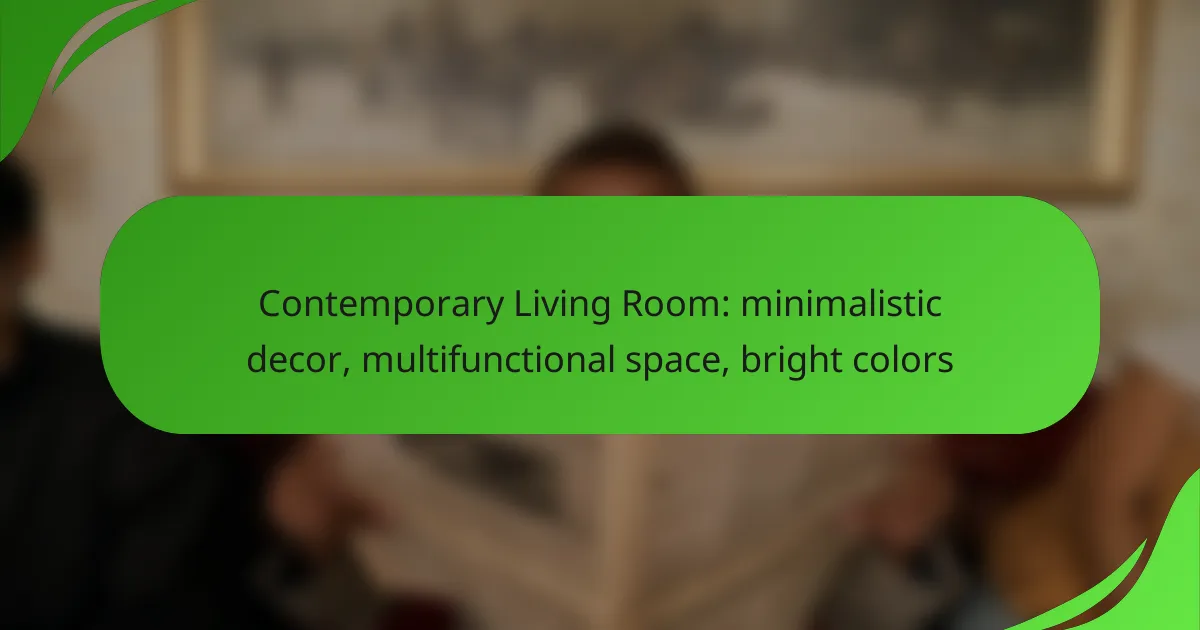Designing an Art Deco hallway invites you to embrace a world of bold patterns, luxurious materials, and vintage elegance. This iconic style, which emerged in the early 20th century, is defined by its geometric shapes, rich textures, and vibrant colors, creating a sophisticated and inviting atmosphere. By incorporating elements like marble flooring, brass fixtures, and decorative glass, you can achieve the timeless allure that Art Deco embodies.

How to design an Art Deco hallway in New York City?
Designing an Art Deco hallway in New York City involves embracing bold aesthetics, luxurious materials, and vintage elegance. Focus on geometric patterns, rich colors, and statement pieces to create an inviting yet sophisticated space.
Incorporate bold geometric patterns
Bold geometric patterns are a hallmark of Art Deco design and can be introduced through wallpaper, tiles, or decorative accents. Consider using chevrons, zigzags, or stylized floral motifs to create visual interest. These patterns can be applied to floors, walls, or even ceiling designs to enhance the overall aesthetic.
When selecting patterns, aim for a balance between complexity and simplicity to avoid overwhelming the space. For instance, a large geometric tile in a neutral color can serve as a stunning focal point while maintaining harmony with other design elements.
Use luxurious materials like marble and brass
Luxurious materials are essential for achieving the opulent feel of an Art Deco hallway. Marble flooring or wall accents can add a touch of sophistication, while brass fixtures and detailing can enhance the overall elegance. Look for polished or brushed finishes to reflect light and create a sense of depth.
Incorporating these materials can be done through various elements such as stair railings, door handles, or decorative moldings. Ensure that the materials complement each other to maintain a cohesive look throughout the hallway.
Choose vintage lighting fixtures
Vintage lighting fixtures play a crucial role in setting the mood of an Art Deco hallway. Opt for chandeliers or sconces that feature geometric shapes and materials like glass and metal. These fixtures not only illuminate the space but also serve as striking decorative elements.
When selecting lighting, consider the scale of your hallway. Larger fixtures can create a dramatic effect in spacious areas, while smaller, intricately designed pieces can add charm to more intimate spaces.
Integrate rich color palettes
A rich color palette is vital for capturing the essence of Art Deco design. Deep jewel tones such as emerald green, sapphire blue, and ruby red can create a luxurious atmosphere. Pair these colors with metallic accents like gold or silver to enhance the opulence.
When choosing colors, consider the natural light in your hallway. Darker hues can make a space feel cozy, while lighter shades can open it up. Use paint, textiles, and decorative elements to achieve the desired effect.
Include statement furniture pieces
Statement furniture pieces can serve as focal points in an Art Deco hallway. Look for items with bold lines, rich fabrics, and unique shapes that reflect the style’s vintage elegance. A striking console table or an ornate bench can enhance the hallway’s character.
When selecting furniture, ensure it complements the overall design theme and does not overcrowd the space. Aim for a few well-chosen pieces that draw the eye and invite exploration of the hallway.

What are the key characteristics of Art Deco design?
Art Deco design is characterized by its bold patterns, luxurious materials, and vintage elegance. This style emerged in the early 20th century and is known for its emphasis on geometric shapes, rich textures, and vibrant colors.
Symmetrical and geometric shapes
Art Deco is defined by its use of symmetrical and geometric shapes that create a sense of order and harmony. Common motifs include zigzags, chevrons, and stylized floral patterns, which can be found in various elements such as wallpaper, flooring, and architectural details.
When incorporating these shapes into a hallway, consider using patterned tiles or wall art that emphasizes symmetry. This approach can enhance the visual flow and create a striking focal point.
Luxurious materials and finishes
Luxurious materials are a hallmark of Art Deco design, often featuring high-quality elements such as marble, polished metals, and exotic woods. These materials not only add elegance but also reflect light, enhancing the overall ambiance of the space.
In a hallway, consider using materials like brass or chrome for fixtures and accents, while opting for rich textiles such as velvet or silk for upholstery. This combination can elevate the space and provide a sense of opulence.
Bold color contrasts
Bold color contrasts are essential in Art Deco design, often featuring combinations of deep hues with metallics or bright accents. Common color palettes include rich jewel tones paired with gold or silver, creating a dramatic effect that captures attention.
To achieve this in a hallway, consider painting walls in deep colors like emerald green or navy blue, then adding gold or chrome accessories. This contrast not only highlights architectural features but also adds depth and interest to the space.

Which materials are best for an Art Deco hallway?
For an Art Deco hallway, the best materials are those that embody bold patterns and luxurious textures. Key choices include marble for flooring, brass for fixtures, and glass for decorative elements, all of which contribute to the vintage elegance characteristic of this style.
Marble for flooring and accents
Marble is a quintessential choice for Art Deco hallways, offering a sense of grandeur and sophistication. Opt for large, patterned tiles or slabs in colors like black, white, or deep green to create striking visual contrasts.
When selecting marble, consider its finish; polished surfaces reflect light beautifully, enhancing the luxurious feel. However, be mindful of maintenance, as marble can be prone to staining and requires regular sealing.
Brass for fixtures and hardware
Brass is ideal for fixtures and hardware in an Art Deco hallway, adding warmth and a touch of opulence. Use brass for door handles, light fixtures, and railings to complement the bold patterns of the space.
Choose pieces with geometric designs or intricate detailing to enhance the vintage aesthetic. Ensure that the brass is well-coated to prevent tarnishing, which can detract from its elegant appearance.
Glass for decorative elements
Glass plays a vital role in Art Deco design, often used for decorative elements like mirrors and light fixtures. Consider using etched or colored glass to introduce unique patterns and reflections that enhance the overall ambiance.
Incorporating glass can also help to create a sense of openness in the hallway. Be cautious with weight and placement, especially for larger glass installations, to ensure safety and stability in your design.

How to choose colors for an Art Deco hallway?
Choosing colors for an Art Deco hallway involves selecting rich, bold hues that reflect the style’s luxurious and vintage elegance. Focus on deep jewel tones, metallic accents, and a balance of neutral shades to create a cohesive and striking atmosphere.
Use deep jewel tones
Deep jewel tones such as emerald green, sapphire blue, and ruby red are quintessential for an Art Deco hallway. These colors evoke a sense of opulence and sophistication, making them ideal for accent walls or decorative elements.
When selecting jewel tones, consider the amount of natural light in your hallway. In darker spaces, opt for brighter shades to prevent the area from feeling too enclosed, while in well-lit areas, you can use richer, darker hues for a dramatic effect.
Incorporate metallic accents
Metallic accents are crucial in enhancing the luxurious feel of an Art Deco hallway. Gold, silver, and bronze can be used in fixtures, frames, or decorative objects to add a touch of glamour and shine.
To effectively incorporate metallics, consider using them sparingly as highlights rather than overwhelming the space. For example, a gold-framed mirror or silver light fixtures can serve as focal points without dominating the color scheme.
Balance with neutral shades
Neutral shades like cream, beige, or soft gray are essential for balancing the bold colors in an Art Deco hallway. These tones provide a backdrop that allows the deeper hues and metallics to stand out without clashing.
When choosing neutrals, aim for warmer undertones to complement the jewel tones and metallics. This creates a harmonious flow throughout the hallway, ensuring that the space feels inviting and well-coordinated.

What vintage elements enhance Art Deco hallways?
Art Deco hallways are characterized by their bold patterns, luxurious materials, and vintage elegance. Key elements that enhance these spaces include antique mirrors, geometric motifs, and rich textures that evoke the opulence of the early 20th century.
Antique mirrors for depth
Antique mirrors are essential for creating depth in Art Deco hallways. Their reflective surfaces can visually expand narrow spaces and add a touch of vintage charm. When selecting mirrors, consider those with ornate frames that feature geometric designs typical of the Art Deco style.
Placement is crucial; position mirrors opposite windows or light sources to maximize natural light and enhance the overall ambiance. Large, statement mirrors can serve as focal points, while smaller ones can be grouped to create an eclectic gallery wall.
Look for mirrors with unique finishes, such as aged patinas or etched patterns, to complement the luxurious materials often found in Art Deco design. Avoid overly modern styles that may clash with the vintage elegance of the hallway.









